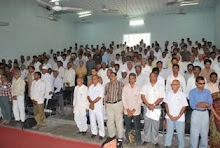The News on Sunday: PK: Sunday, December 17, 2017.
Twenty years
after the promulgation of the first Freedom of Information (FOI) Ordinance in
1997, the Pakistani right to information (RTI) scene looks dynamic. The country
has made significant progress in terms of legislation on access to information
during the past twenty years. The inclusion of Article 19A (Right to
Information) in the constitution is one of the major developments. Resultantly,
we have started moving from first generation FOI laws to second generation RTI
laws.
At the
moment, these RTI laws are in force in Khyber Pakhtunkhwa, Punjab and Sindh, as
well as at the federal level. However, Balochistan still lives with the old FOI
law which was enacted in 2005.
The fact of
the matter is that all ‘good’ that has happened with regards to citizens access
to information has happened only on paper. A lot is needed on the ground.
While these
second-generation RTI laws are similar in several respects, those being applied
in the provinces do differ from each other. These similarities and differences
are found both in the substance of the laws as well as in their administrative
side. The laws have several operational challenges like non-existence of
information commissions, non-allocation of budgets and absence of required
staff to run their days to day business. Apart from that the bureaucratic
mindset and traditional culture of secrecy among public officials is a serious external
challenge in the way of effective and meaningful implementation of these laws.
Here is a quick comparison of RTI laws to see how each one is helpful to
information seekers, both in terms of substance and implementation.
Defining
public bodies and public information
What is
‘public information’? Defining ‘public bodies’ and ‘public information’ is the
first step towards access to information. We first need to take a look at the
list of organisations which receive public money or perform public functions,
for those are the ones that are meant to fall under the RTI law. In this
respect, definition of ‘public body’ in the federal RTI law looks quite wide.
Besides covering all public-sector organisations including ministries,
divisions, attached departments, Senate and National Assembly, statutory
bodies, courts, tribunals, etc., it ironically covers even ‘registered’
non-governmental organisations, which neither receive any public fund nor
undertake any specific public function. However, provincial RTI laws are
extended only to those NGOs which receive ‘substantial public funds’ or perform
a specific public function.
Our
provincial laws define ‘public information’ as all information held by public
bodies, except the one explicitly exempted by the law itself. However, the
federal RTI law defines ‘public record’ only as a limited list of information
held by public bodies. Rest of the information of the ‘public body’ shall
remain beyond public access. In this aspect, the federal RTI law is a copy of
the old, inadequate and toothless FOI Ordinance of 2002, hence limited in scope
and application.
Proactive
Information Disclosure
One of the
best aspects of these second-generation RTI laws is the concept of ‘proactive
disclosure of information’. These laws require public bodies to proactively
disclose certain information to the public via the internet or other platforms
to ‘best ensure accessibility for the public.’ This includes proactive
disclosure of information about the structure of an organisation, its
functions, the different categories of information held by the body, policies,
guidelines, duties, powers, rules, regulations, orders, notification,
description of decision-making processes, budget, subsidies, concession and
permits granted, and facilities for public’s access to information. It also
includes the names, designations and particulars of public information
officers. However, a research conducted in 2015 by the Digital Rights
Foundation concludes that not more than 25 per cent of public bodies have put
out any of this information proactively.
Institutional
mechanisms
Another
significant aspect which makes the RTI laws different from the old FOI laws is
the establishment of ‘information commissions.’ The purpose of these
commissions is to facilitate the public’s access to information and to provide
dedicated mechanisms for effective implementation of the law. Each commission
consists of three members; one advocate of High Court or Supreme Court
qualified to be a judge of the High Court, one civil society representative
having a minimum of fifteen years of relevant experience and one retired senior
public official (of grade-22 or equivalent in case of federal law, grade-20 in
Khyber Pakhtunkhwa, grade-21 or equivalent in Punjab and grade-20 in Sindh).
At the
federal level the prime minister has the sole authority to appoint members of
the ‘Pakistan Commission on Access to Information’ for a single term of four
years. However, under provincial RTI laws, the collective wisdom of the
provincial governments consisting of the CM and the cabinet decides about the
members of their respective information commissions for a single term of three
years.
Application
process duration and costs
All four
provincial RTI laws permit all Pakistani citizens, irrespective of their
province of domicile to apply for information. However, there are slight
differences in the application disposal process. The Khyber Pakhtunkhwa and
federal law stipulate 10 days for provision of information; Punjab RTI law
provides 14 days; and Sindh RTI law gives 15 days for disposal of information
request. The Khyber Pakhtunkhwa and federal laws are silent in this regard.
However, if it is a matter of life and liberty of human beings, public bodies
are bound to provide information within two working days in case of provincial
laws, and within three days in case of federal law.
Moreover,
there is no fee for making request for information under any of these laws.
However, you may be charged the cost of making. In Punjab and Sindh, a public
body can charge actual cost of copies from the applicant. However, in Khyber
Pakhtunkhwa, a public body can charge actual cost only if the number of copies
exceed 20 pages.
Hurdles
and barriers
It is worth
mentioning that local and international RTI experts and activists have welcomed
these second-generation RTI laws in the country. The Centre for Law and
Democracy (CLD), an internationally renowned organisation working on the right
to information, has ranked all provincial RTI laws quite highly. But it is
pertinent to share that CLD and other experts have expressed their concerns
over the limitations of the federal law. However, despite limitations, the
picture of RTI regimes in the country appears quite colourful on paper. In
reality, the situation is quite different. With the exception of Khyber
Pakhtunkhwa’s Right to Information Commission, there is virtually no
institutional access to information mechanism present at any level.
This reality
check is evident from the fact that the Punjab Information Commission has been
dysfunctional since March 2017 when two of its commissioners completed their
term. The third commissioner, upon completion of his term, left in April 2017.
Besides, the stories of difficulties faced by the previous commission at the
hands of bureaucracy and establishment are quite disturbing. The commission
worked without a dedicated office space for more than a year. Even after the
allocation of budget and office space, the commission struggled in getting
required human resources during its entire tenure.
The Sindh
Transparency and Right to Information Act, 2016, which started functioning on
April 12, 2017, requires the establishment of the information commission within
one hundred days of enactment of the law. However, on ground, nothing seems to
be happening. This is also true for the federal Right to Access to Information
Act 2017, which came into effect in October 2017.
The fact of
the matter is that all ‘good’ that has happened with regards to citizens access
to information has happened only on paper. A lot is needed on the ground.
Because there is no utility of these laws unless the governments establish RTI
Commissions as implementation mechanisms. Otherwise, citizens’ dream to have
access to information will remain a dream even after twenty years.















































































